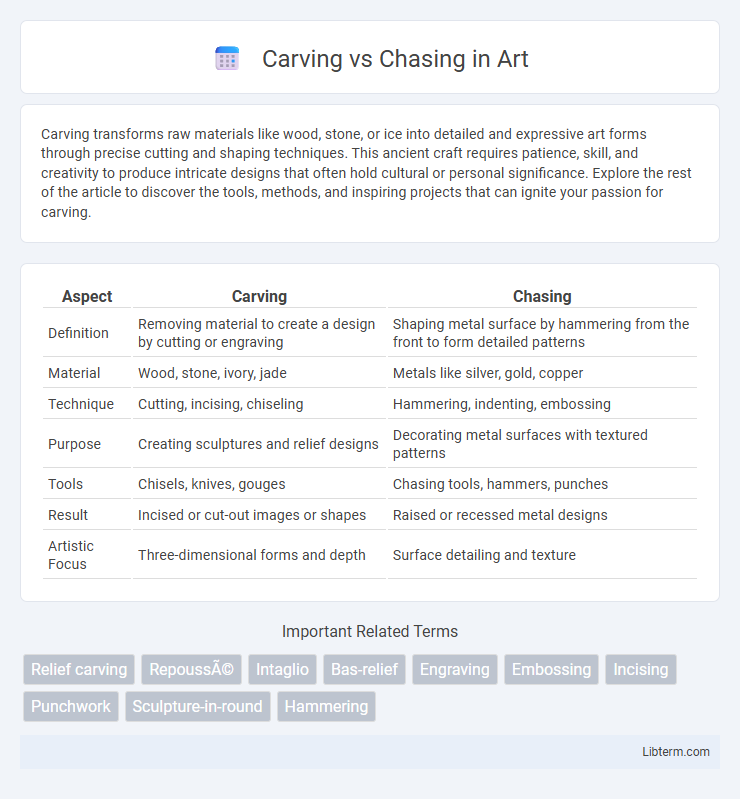Carving transforms raw materials like wood, stone, or ice into detailed and expressive art forms through precise cutting and shaping techniques. This ancient craft requires patience, skill, and creativity to produce intricate designs that often hold cultural or personal significance. Explore the rest of the article to discover the tools, methods, and inspiring projects that can ignite your passion for carving.
Table of Comparison
| Aspect | Carving | Chasing |
|---|---|---|
| Definition | Removing material to create a design by cutting or engraving | Shaping metal surface by hammering from the front to form detailed patterns |
| Material | Wood, stone, ivory, jade | Metals like silver, gold, copper |
| Technique | Cutting, incising, chiseling | Hammering, indenting, embossing |
| Purpose | Creating sculptures and relief designs | Decorating metal surfaces with textured patterns |
| Tools | Chisels, knives, gouges | Chasing tools, hammers, punches |
| Result | Incised or cut-out images or shapes | Raised or recessed metal designs |
| Artistic Focus | Three-dimensional forms and depth | Surface detailing and texture |
Introduction to Carving and Chasing
Carving involves cutting or gouging material such as wood, stone, or metal to create a design by removing parts of the surface. Chasing refers to detailing metal surfaces by hammering from the front to refine or define the design without removing any material. Both techniques are essential in decorative arts, with carving primarily used for deep relief and chasing for intricate surface embellishments.
Historical Background of Carving and Chasing
Carving and chasing are ancient decorative techniques with distinct historical roots; carving involves removing material to create a design, dating back to prehistoric times when early humans carved bone, wood, and stone. Chasing, by contrast, originated in metalworking traditions of ancient civilizations such as Mesopotamia and Egypt, where artisans hammered designs into metal surfaces without removing material. The evolution of carving is closely linked to cultural artifacts like Egyptian hieroglyphs and Gothic woodwork, highlighting its longstanding role in artistic expression across diverse materials.
Defining Carving: Techniques and Tools
Carving involves removing material from a solid block using tools like chisels, gouges, and mallets to create three-dimensional shapes and textures. Techniques vary from relief carving, where designs are raised from the background, to intaglio, which involves incising patterns below the surface. This method emphasizes depth, volume, and form, distinguishing it from chasing, which primarily works on surface detailing without significant material removal.
Understanding Chasing: Process and Applications
Chasing is a metalworking technique that involves refining and detailing a metal surface by displacing rather than removing material, using specialized chasing tools and hammers. This process is widely applied in decorative arts for creating intricate patterns and textures on jewelry, armor, and metal sculptures, enhancing both aesthetics and surface durability. Understanding chasing emphasizes precision and control, allowing artists to manipulate metal with subtle depth and detail compared to the deeper cuts achieved in carving.
Key Differences Between Carving and Chasing
Carving involves removing material to create a design by cutting into the surface, often resulting in deep grooves and three-dimensional shapes, whereas chasing focuses on detailing the metal surface by hammering from the front to create intricate patterns without material removal. Carving typically uses tools like chisels and gouges to shape wood, stone, or metal, while chasing employs specialized punches and hammers to refine metalwork textures and lines. The primary distinction lies in carving shaping the form through subtractive techniques, whereas chasing enhances surface decoration through controlled deformation.
Materials Used in Carving and Chasing
Carving typically uses materials such as wood, stone, and ivory for creating deep reliefs and three-dimensional shapes, allowing artists to remove material to form intricate designs. Chasing involves softer metals like silver, gold, and copper, where the surface is manipulated without removing metal, producing detailed patterns and textures through hammering and embossing techniques. The choice of material greatly influences the technique's application, with carving suited for rigid substances and chasing ideal for malleable metals.
Popular Styles and Artistic Outcomes
Carving techniques in sculpture often produce bold, three-dimensional forms with deep textures, favored in styles like Gothic and Baroque that emphasize dramatic shadows and intricate details. Chasing, used primarily in metalwork, refines surfaces with delicate patterns and subtle relief, prominent in Art Nouveau and Classical styles, enhancing ornamental elegance and fine detailing. Both methods influence artistic outcomes by shaping visual depth--carving creates striking structural contrasts while chasing offers refined surface sophistication.
Choosing the Right Technique for Your Project
Carving involves removing material to create depth and dimension, ideal for bold, three-dimensional designs, while chasing enhances surface detail by hammering patterns without cutting through the metal. Selecting the right technique depends on the project's aesthetic goals; carving suits deep relief work in wood or stone, whereas chasing excels in refining metal surfaces with intricate textures. Consider the material type and desired visual effect to ensure precision and durability in your finished piece.
Common Challenges and How to Overcome Them
Carving and chasing both demand precision and control, but common challenges include maintaining consistent depth and avoiding material damage. Achieving clean lines requires steady hand pressure and proper tool selection to prevent slips or uneven cuts. Overcome these obstacles by practicing on softer materials, using high-quality tools, and employing techniques like sketching designs beforehand to guide accurate carving and chasing.
Future Trends in Carving and Chasing Arts
Future trends in carving and chasing arts emphasize the integration of digital technologies such as 3D modeling and laser engraving to enhance precision and creativity. Sustainable materials and eco-friendly practices are gaining traction, driving innovation in traditional metalworking techniques. Increased collaboration between artisans and technologists is expanding the boundaries of carving and chasing, blending craftsmanship with modern design aesthetics.
Carving Infographic

 libterm.com
libterm.com